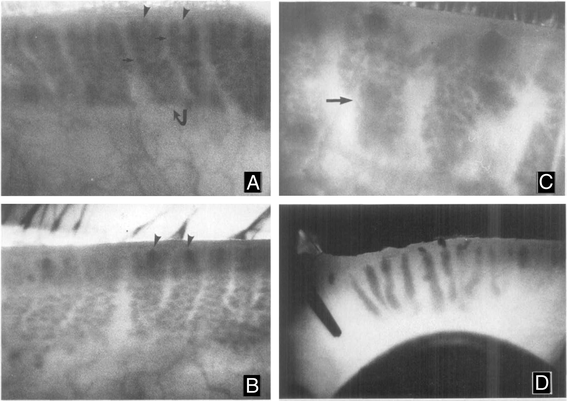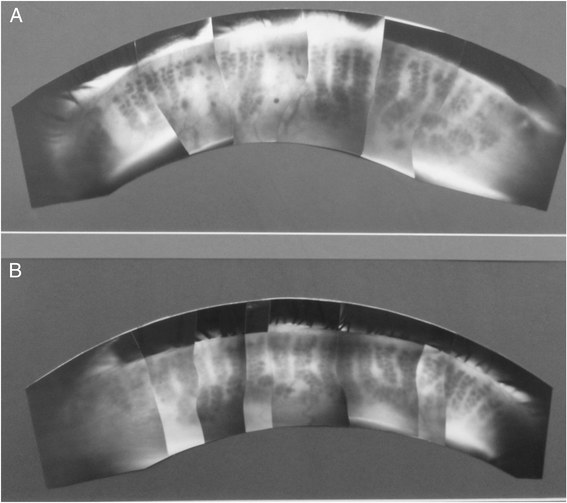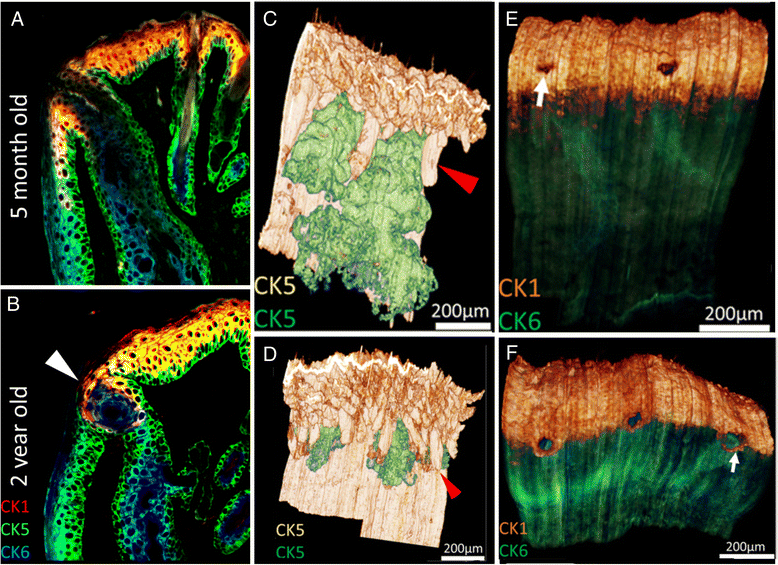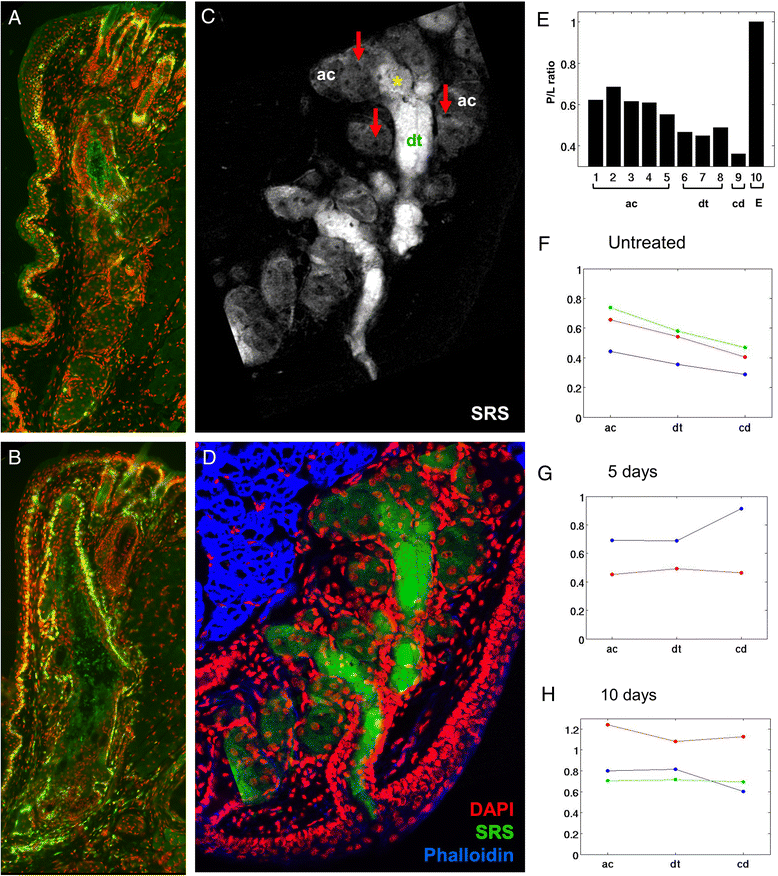Meibomian gland dysfunction: hyperkeratinization or atrophy?
- PMID: 26817690
- PMCID: PMC4895318
- DOI: 10.1186/s12886-015-0132-x
Meibomian gland dysfunction: hyperkeratinization or atrophy?
Abstract
Meibomian gland dysfunction (MGD) is the major cause of evaporative dry eye disease (EDED) and dysfunction is widely thought to mechanistically involve ductal hyperkeratinization, plugging and obstruction. This review re-evaluates the role of hyperkeratinization in MGD based on more recent findings from mouse models. In these studies, eyelids from normal young and old mice or mice exposed to desiccating stress were evaluated by immunofluorescent tomography and 3-dimensional reconstruction to evaluate gland volume, expression of hyperkeratinization markers and cell proliferation or stimulated Raman scattering (SRS) microscopy to assess lipid quality. Results indicate that aging mice show dropout of meibomian glands with loss of gland volume and a forward migration of the mucocutaneous junction anterior to the gland orifice; similar age-related changes that are detected in human subjects. Atrophic glands also showed evidence of epithelial plugging of the orifice without the presence of hyperkeratinization. Mice exposed to desiccating stress showed hyperproliferation of the meibomian gland and ductal dilation suggesting a marked increase in lipid synthesis. Lipid quality was also affected in EDED mice with an increase in the protein content of lipid within the duct of the gland. Overall, age-related changes in the mouse show similar structural and functional correlates with that observed in clinical MGD without evidence of hyperkeratinization suggesting that gland atrophy may be a major cause of EDED. The response of the meibomian gland to desiccating stress also suggest that environmental conditions may accelerate or potentiate age-related changes.
Figures




Similar articles
-
Meibomian gland dysfunction. II. The role of keratinization in a rabbit model of MGD.Invest Ophthalmol Vis Sci. 1989 May;30(5):936-45. Invest Ophthalmol Vis Sci. 1989. PMID: 2470694
-
Recent advances in age-related meibomian gland dysfunction (ARMGD).Ocul Surf. 2023 Oct;30:298-306. doi: 10.1016/j.jtos.2023.11.003. Epub 2023 Nov 17. Ocul Surf. 2023. PMID: 37979775 Free PMC article. Review.
-
Absence of ductal hyper-keratinization in mouse age-related meibomian gland dysfunction (ARMGD).Aging (Albany NY). 2013 Nov;5(11):825-34. doi: 10.18632/aging.100615. Aging (Albany NY). 2013. PMID: 24259272 Free PMC article.
-
Effect of desiccating stress on mouse meibomian gland function.Ocul Surf. 2014 Jan;12(1):59-68. doi: 10.1016/j.jtos.2013.08.002. Epub 2013 Oct 18. Ocul Surf. 2014. PMID: 24439047 Free PMC article.
-
The Relationship Between Morphology and Function of the Meibomian Glands.Eye Contact Lens. 2018 Jan;44(1):1-5. doi: 10.1097/ICL.0000000000000336. Eye Contact Lens. 2018. PMID: 27755288 Review.
Cited by
-
Characterization of the thickness of the Tear Film Lipid Layer in Meibomian Gland Dysfunction using high resolution optical microscopy.Ocul Surf. 2022 Apr;24:34-39. doi: 10.1016/j.jtos.2021.12.011. Epub 2021 Dec 27. Ocul Surf. 2022. PMID: 34968765 Free PMC article.
-
Expression of extracellular matrix components in the meibomian gland.Front Med (Lausanne). 2022 Sep 6;9:981610. doi: 10.3389/fmed.2022.981610. eCollection 2022. Front Med (Lausanne). 2022. PMID: 36148459 Free PMC article.
-
Dysregulation of Lipid Metabolism in Aging Meibomian Glands and Its Molecular Markers.Int J Mol Sci. 2023 Aug 31;24(17):13512. doi: 10.3390/ijms241713512. Int J Mol Sci. 2023. PMID: 37686319 Free PMC article.
-
Clinical safety and efficacy of vitamin D3 analog ointment for treatment of obstructive meibomian gland dysfunction.BMC Ophthalmol. 2017 Jun 7;17(1):84. doi: 10.1186/s12886-017-0482-7. BMC Ophthalmol. 2017. PMID: 28592257 Free PMC article. Clinical Trial.
-
Relation of Dietary Fatty Acids and Vitamin D to the Prevalence of Meibomian Gland Dysfunction in Japanese Adults: The Hirado-Takushima Study.J Clin Med. 2021 Jan 18;10(2):350. doi: 10.3390/jcm10020350. J Clin Med. 2021. PMID: 33477594 Free PMC article.
References
-
- Jester JV, Nicolaides N, Smith RE. Meibomian gland studies: histologic and ultrastructural investigations. Invest Ophthalmol Vis Sci. 1981;20:537–547. - PubMed
Publication types
MeSH terms
Substances
Grants and funding
LinkOut - more resources
Full Text Sources
Other Literature Sources
Medical

